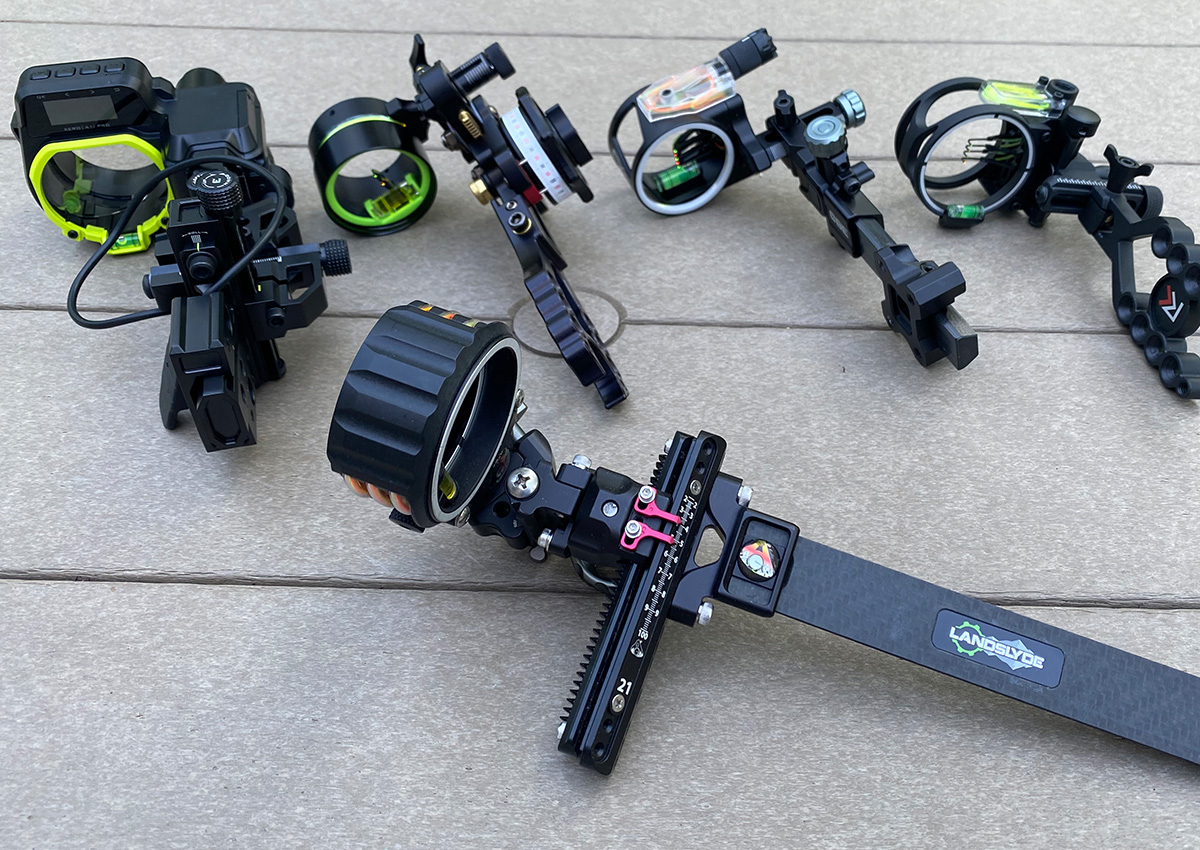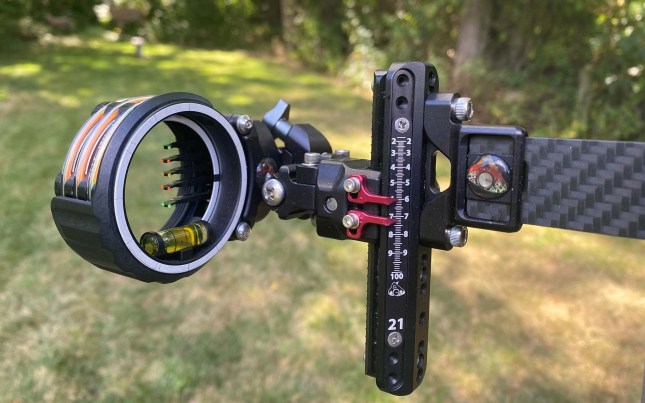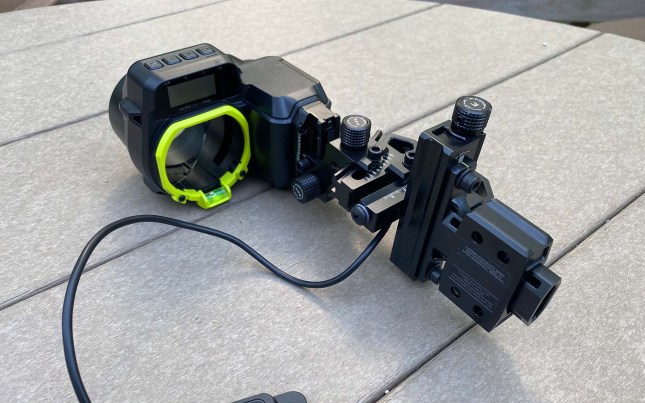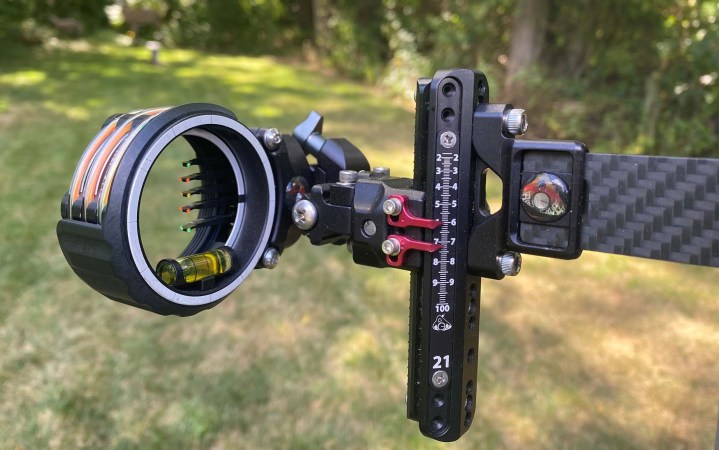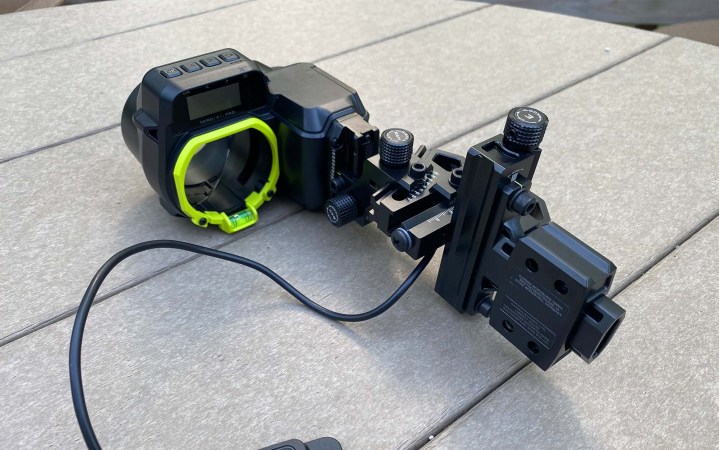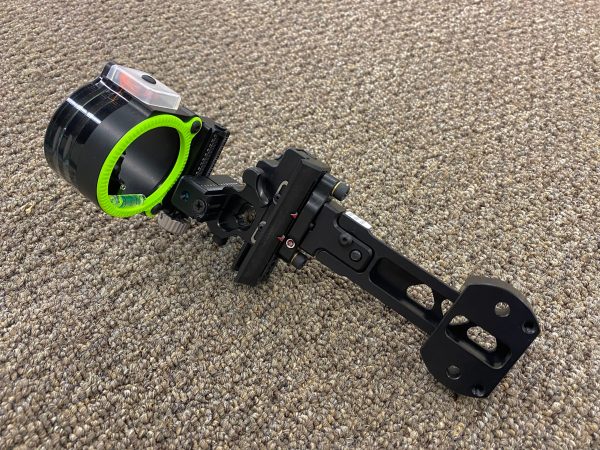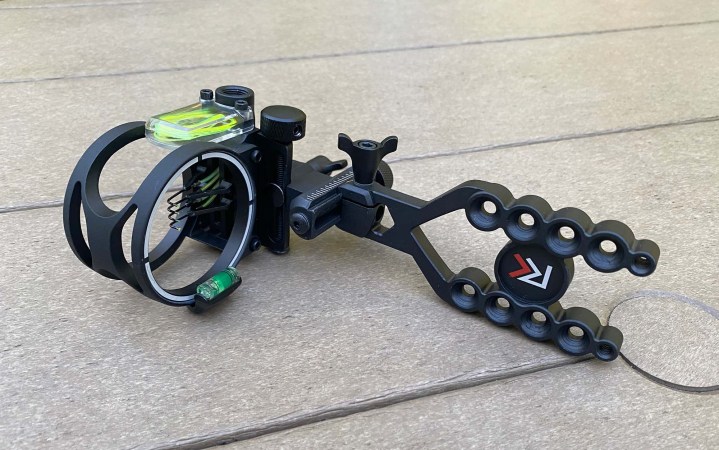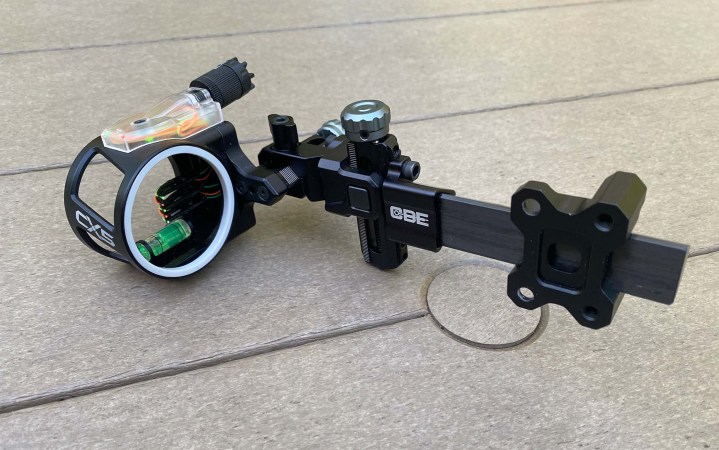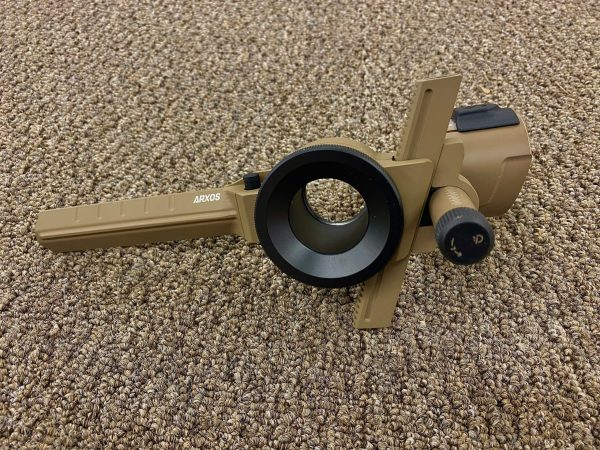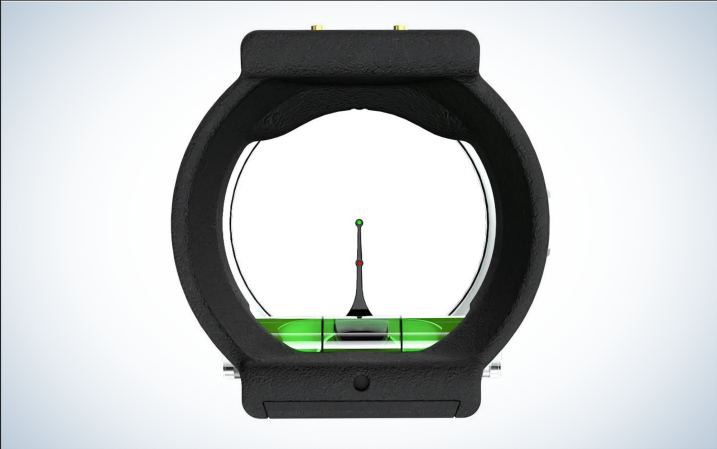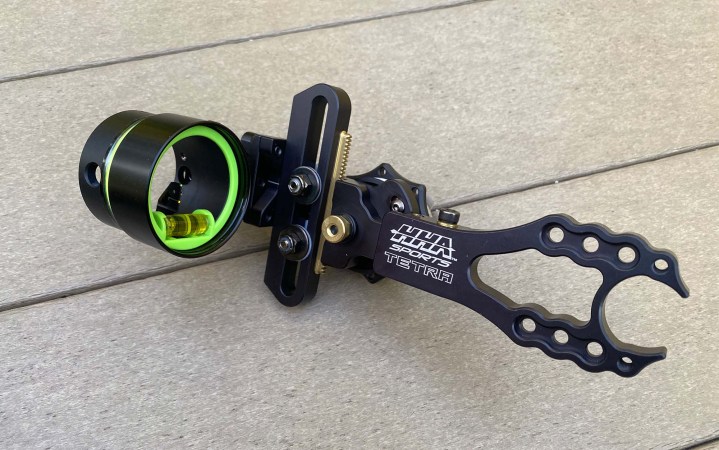We may earn revenue from the products available on this page and participate in affiliate programs. Learn More ›
Bow sights today are more advanced and feature laden than at any other time in history. I remember in the early 1990s when the big advancement was the change from metal pins with painted balls on the tips to pins that had colored plastic cylinders at the ends. Those were game changers back in the day.
Today’s bowhunters can choose sights with fixed or movable pins, sights with digital sight tapes, sights with built-in rangefinders and electronic readout screens, and on and on. The options are nearly limitless.
What hasn’t changed, however, is the fact that a good sight won’t make up for lack of shooting skill or a lousy bow tune. A bow sight is a tool that functions best in the hands of a skilled worker. The better you become at archery, the better a good sight can help you move closer to perfection.
But not everyone is at the same point on that road to perfection, and so different people have different needs and capabilities. Not everyone needs the most expensive, most advanced bow sight. And that’s where the market has responded. Wherever you are in your archery journey, there’s a best bow sight for you.
- Best Overall: Axcel Landslyde 5-pin
- Best Rangefinding Sight: Garmin Xero A1i Pro
- Best Single Pin: Black Gold Pro Dual Trac
- Best Budget: Redline RL4
- Best Lightweight: CBE CX-5
- Most Unique Looking: Dialed ARXOS
- Best Aftermarket Hunting Scope: UltraView UV3XL Hunting Scope
- HHA Tetra Ryz
The Best Bow Sights: Reviews and Recommendations
Best Overall: Axcel Landslyde 5-pin
Key Features
- Five fixed pins mounted on a movable vertical post
- Two sight tape indicators can be set to mark the top and bottom pins
- Movable rheostat
- Long lengths of high-quality fiber optic
- Adjustable on both second and third axes
Pros
- Offers the best of both worlds – fixed pins that can be adjusted on the fly
- Built like a tank
- Super bright pins that can be quieted in bright sun
- Comes with metal sight tapes
Cons
- Expensive
- Can be hard to find due to high demand
The Axcel Landslyde five-pin sight is the ultimate bowhunting sight. It offers the quick aiming of five-fixed-pins sight, and the adjustable precision of a sliding, single-pin sight. So if you’ve got your five pins set at 20, 30, 40, 50, and 60 yards, you’ve got fixed aiming references if your target buck comes racing in to 20 yards, but then scoots out to 35 after you’ve come to full draw, but before you could shoot. Stay at full draw, and simply move to the gap between your 30- and 40-yard pins.
On the other hand, if you’ve got the time, you can dial your sight to the exact yardage that buck is standing at so you can paste a pin to the spot you want to hit. No gap shooting if you don’t want to gap shoot.
The micro-adjust system for moving each individual pin is ingenious and it takes minutes to sight in your bow. Each pin is held in place by a locking screw. Underneath the pin stack is a dial. You unlock one pin and turn the dial, and then only that pin moves up or down. You are able to make tiny adjustments with the dial, so you can get each pin in exactly the right place. Once a pin is set, tighten the locking screw, and it won’t budge.

When you get the Landslyde in your hands, it’s easy to understand why it’s fairly expensive. You can feel the quality. The pins are bladed, so they won’t bend. The fiber optic is incredibly bright in even the dimmest light. And if it happens to be super bright outside and your pin is starbursting, you can slide the rheostat to cover up some of the fiber, which dulls the pin and eliminates the starburst.
Every sight comes with a good selection of metal and coated paper sight tapes. Odds are, one will work for your setup. If you can get a metal tape to work, you don’t ever have to worry about it getting wet or tearing. With the dual indicators, you can set the top arrow to mark your top pin and the bottom to match your bottom pin. That way, you can use your top pin as a single pin sight from 0-60 yards, and your bottom pin for aiming at anything beyond 60 yards.
We’ve chosen the five-pin sight as the best, but Axcel offers the Landslyde in three-pin and single-pin configurations. You choose what you prefer. You can also choose between versions where the sight bar mounts directly to the riser, or which slides through a mounting block so you can easily adjust how close to or far from the riser the scope sits.
Best Rangefinding Sight: Garmin Xero A1i Pro
Key Features
- Operated by the touch of a button attached to the bow’s grip
- Can be set to account for multiple arrow setups
- Choose red or green aiming dot
- Choose single dot that appears at a ranged distance, or a stack of preset dots similar to a fixed-pin sight
- Micro-adjust windage, elevation, and scope pitch
- Quick disconnect cord so sight can be removed from the bow for travel
Pros
- Incorporates rangefinding and aiming into one action
- With the push of a button, puts an aiming dot precisely on your target
- Can be preset to account for a light arrow and a heavy arrow
- Instructions for setup are built into the menu
Cons
- Can be intimidating to bowhunters not comfortable with advanced technology
- Very expensive
The Garmin Xero A1i Pro is a bow sight that also functions as a rangefinder. It can be set to that when you press a button attached to the front of the bow grip to range a target, the distance will appear in a display, and an illuminated dot will appear on a screen in the scope housing at the exact spot where it would need to be to aim dead-on at that target. Or it can be set with a series of fixed aiming references set at 10-yard intervals and pressing the rangefinding button simply displays the distance to the target.

The Pro is the newest version of the Xero A1i, and includes micro-adjust capabilities for elevation, windage, and the pitch and yaw of the scope. The pitch and yaw ensure the display screen in the scope is perfectly flat to the user’s eye. That’s key for accurate rangefinding.
Setup for the Xero A1i Pro does take several steps, but you’re guided through those steps by on-screen directions. Follow those directions, and setup is not difficult.
The customization this sight affords is unparalleled. Besides choosing between single-pin or multi-pin aiming, you can choose the pin colors, set up an on-screen digital level if you want, and set the sight to account for normal or extended-range shooting, among other options. You can even set the sight to adjust for different arrow profiles.
You can read the full Garmin Xero A1i Pro review here.
Best Single Pin: Black Gold Pro Dual Trac
Key Features
- Pin Size: .019
- Housing size: 1 3/4″
- Weight: 9.4oz
- Adjustment wheel
- Includes a second, lower aiming reference that can be adjusted up or down
- Dual indicators on sight wheel match each aiming reference
- Solid gear system with zero slop
- Pin fiber is protected under a clear plastic cover for maximum light gathering with maximum protection
- Dovetail mount allows the sight to be removed for transportation and is Bridge-Lock compatible
Pros
- Can set the aiming pin fast and easy
- Separately adjustable lower pin
- Lots of fiber to light up the pin at prime time
- Skinny, bladed pins to minimize target blocking
Cons
- Vertical bar could be longer to allow for longer shooting
The Black Gold Pro Dual Trac Dovetail Sight is a solid, but lightweight sight at just 9.4 ounces, making it a solid choice for bowhunters looking to minimize bow weight, but who still want a sight with all the bells and whistles. At its core, this is an adjustable, single-pin sight. You set up a sight tape, range your target and move your sight pin to the desired distance.

However, Black Gold has added a second pin under the main pin, and that second pin is individually adjustable. On many sights that offer a second pin like this, it’s fixed, and you have to figure out the distance it’s set for as you move your main pin. On this sight, you set your main pin, and then you can adjust the second pin up or down to a distance that suits you. Two sight-tape indicators are adjustable so you can set them to match each pin. And those pins are bladed for strength, yet super skinny to the shooter’s eye to minimize how much the pins cover your target.
The dovetail bar allows you to slide the scope closer to or farther from the riser so you can get your sight picture the way you want. Also, the dovetail is sized to work with any bow (currently only newer Mathews bows) featuring the Bridge-Lock sight mounting system.
Windage and elevation adjustments used for setup are both micro-adjustable. The fiber for each pin is housed inside a clear plastic container located on top of the scope for maximum light-gathering, yet keeping the fiber safe from the elements. Included in the pack are 54 stick-on sight tapes. With that many offerings, there’s likely one in the pack that will match your bow and arrow setup.
Best Budget: Redline RL4
Key Features
- Tool-free locking adjustment knobs
- Precision click windage and elevation adjustments
- Lightweight
- Four fixed pins with lots of fiber
- Multiple mounting points
- Built-in level
Pros
- Costs under $75
- Solid construction
- It can be leveled on the second and third axes
- Light included
Cons
- Pins aren’t the brightest in low light
- Pins are thin wire, which could bend if a stick gets inside the scope
The Redline RL4 includes a lot of features bowhunters look for in a high-end sight, but it costs less than $75. It’s a four-pin sight with micro-adjust click dials for windage and elevation. And those adjustment dials can be locked and unlocked without using any tools. Hand-tighten knobs keep them secure.
The pins are made of thin wire, but keep debris out of the scope and you’ll be fine. Each pin has a good amount of fiber that’s all stored in a clear plastic case mounted to the top of the scope for optimum light gathering, while the fiber is also protected. In normal lighting situations, the pins glow nicely.
This sight can be adjusted to level it on the second and third axes, which is unusual for a sight in this price range. So bowhunters can rest assured that when the bubble is in the middle of the level, the sight truly is level.
Four sets of pre-drilled holes in the sight arm allow for attaching the sight to the bow, so the scope sits at different distances from the riser. This allows some customization in getting the sight picture through the peep the way you want it.
Best Lightweight Sight: CBE CX-5
Key Features
- High modulus carbon bar is ultralight but ultra strong
- Five bladed pins
- Dovetail mount so you can easily move the scope in and out from the riser
- 12 inches of fiber per pin, and the fiber is protected in a clear plastic case on top of the scope
- Lockable, micro-adjust towers for windage and elevation
Pros
- Very light and still feature loaded
- Pins are super bright and super strong
- Can be leveled on the second and third axes
- Comes with interchangeable, fluorescent scope rings—green, red, yellow and grey
Cons
- Five pins, but only two colors—red and green
The CBE CX-5 is built for the hunter concerned about overall bow weight, but who still wants a sight that has all the features of the most advanced sights. Weighing just 9 ounces, the CX-5 is a five-pin sight that has a foot of fiber for each pin, a built-in level, micro-adjust drive systems for windage and elevation, and is adjustable on the second and third axes.
The sight features a 3-inch dovetail bar with four locking positions for moving the sight in and out of the mounting block that’s attached to the bow. This allows the user to fine-tune the scope distance from the riser to get the best sight picture through the peep.
On top of the scope, there’s a clear plastic case that houses all the pin fiber. The clear plastic allows light to get to each fiber strand, so they can light up the pin ends, but it also protects the fiber from tree branches, brush, and other outside elements which could break the fiber. Included with the sight is a blue light that attaches to the fiber case, in case artificial light is needed in low-light conditions.
Despite weighing only 9 ounces, the CX-5 is built strong. The carbon bar that cuts weight in super stiff and will not bend. To get the bladed pins to bend, something catastrophic would have to happen. The usual stick running through the scope isn’t going to affect these pins. CBE cut weight from a high-end bow sight, without stripping features or sacrificing strength.
Most Unique Looking: Dialed ARXOS
Key Features
- Adjustable, single pin sight which includes a second aiming reference below the main one, on the same sight post
- Two yardage pointers, which can be individually set for each sight pin on the adjustment wheel
- Twenty-degree angled vertical bar allows for greater shooting distance as compared to a straight vertical bar
- The Void Dial is a large wheel that’s turned to raise the scope in setting the shooting distance. Inside the wheel is nothing, leaving a big hole in the sight
- Scope level is mounted to the top of the scope to offer a greater field of view at the bottom
- Cerakote finish in black, brown (Earth), olive (Sage) or gray (Smoke)
Pros
- Solid, heavy-duty sight that can take a beating
- Dual aiming points extend the sight’s range
- Angled vertical bar extends the sight’s range
Cons
- Expensive
- Angled bar does extend the sight’s range, but not as much as you might think
The ARXOS sight by Dialed Archery is an eye-grabber. With its slanted vertical bar, the giant hole in it when viewed from the side and the cool matte colors, the ARXOS just doesn’t look like other compound bow sights.
The Dialed ARXOS is an adjustable, single-pin sight that offers a second, lower aiming reference on the sight post. So when you max out the sight’s distance, you can switch to the lower aiming point to gain yardage.
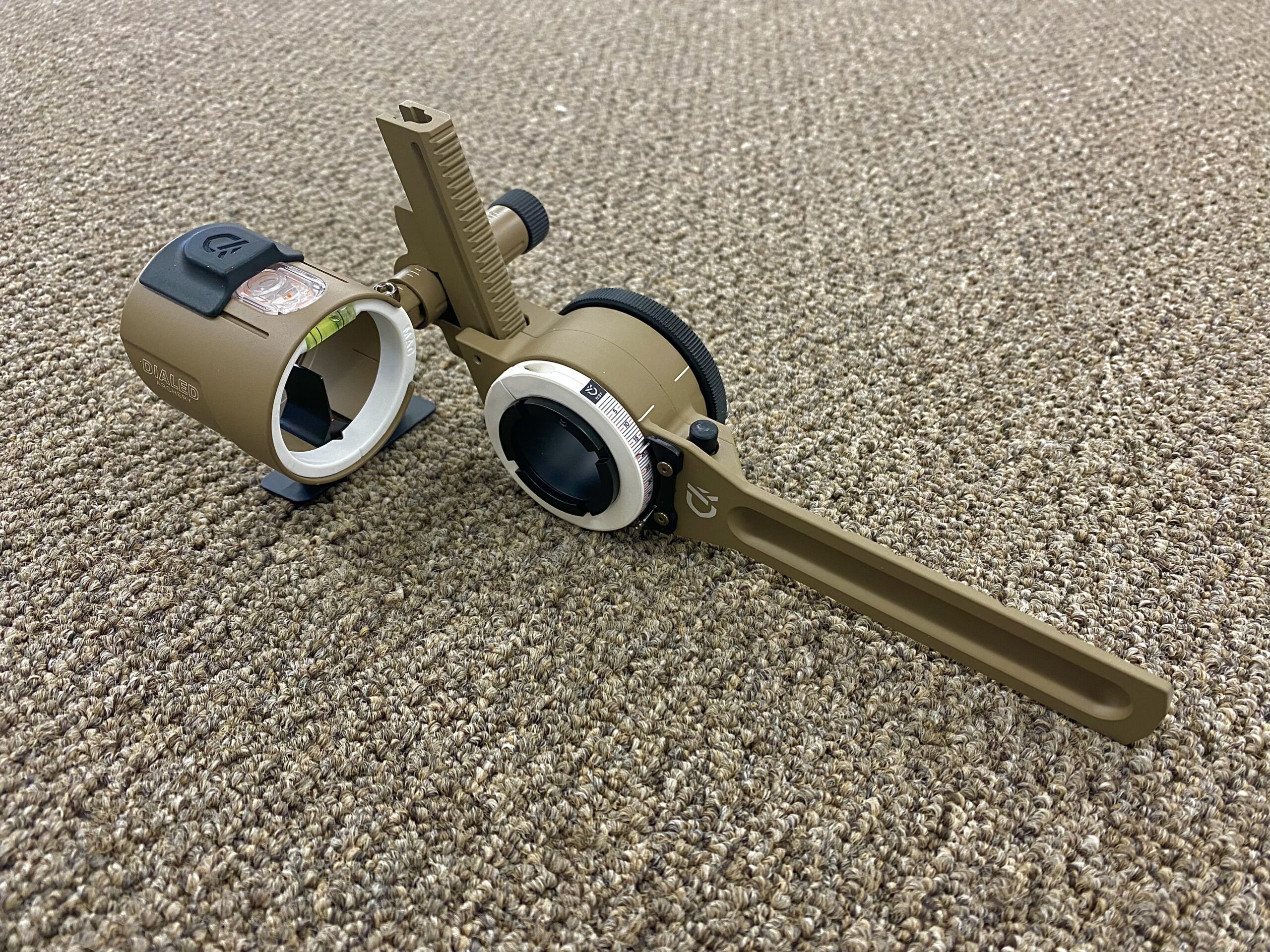
The 20-degree angle in the bar brings the scope closer to your eye as you lower it for longer distances. That move extends the sight’s range, as compared to a straight vertical bar. The horizontal distance between the lower and upper ends of the bar is not that great, and so many users are estimating they are getting about 5-10 more yards because of the angle. Just know that going in, as some hunters have thought they’d gain a lot more distance.
The Void Dial is the large wheel that’s turned to adjust the scope up and down. Dialed decided just to leave the inside of the wheel blank, which creates a unique look for this sight. They provide sight tapes, which stick to the sight tape ring. The ring features two adjustable indicator pins that can be individually set for each aiming reference. So when you adjust the scope, you’ll know exactly how far to shoot using the top pin and the lower pin.
The ARXOS sight, with its Cerakote finish, is built for backcountry hunting and Total Archery Challenge abuse. It’s sturdy and can take a beating.
Best Aftermarket Hunting Scope: UltraView UV3XL Hunting Scope
Key Features
- 41mm scope housing allows for large field of view favored by bowhunters and 3D shooters
- Cartridge system allows for swapping between one and two pins, no pins and lenses
- Five internal LEDs for pin and/or level illumination
- Two batteries installed, plus two more included with the scope
- Attaches to any sight that accepts 10-32 rods
Pros
- Allows for multiple scope setups with one housing
- Provides optimum sight picture for bowhunting and 3D shooting
- Can be added to many sights on the market
Cons
- Useless without a sight body
- Expensive
Customization is the name of the game in archery today, and so many bowhunters aren’t satisfied with the standard scopes that come on various bowhunting sights. The UV3XL is a scope that can be added to many adjustable sights on the market, including ones made by Spot Hogg, Axcel, and HHA. The scope features one or two aiming references, a level, and a built-in light for illuminating the aiming pin and level, or either one individually.
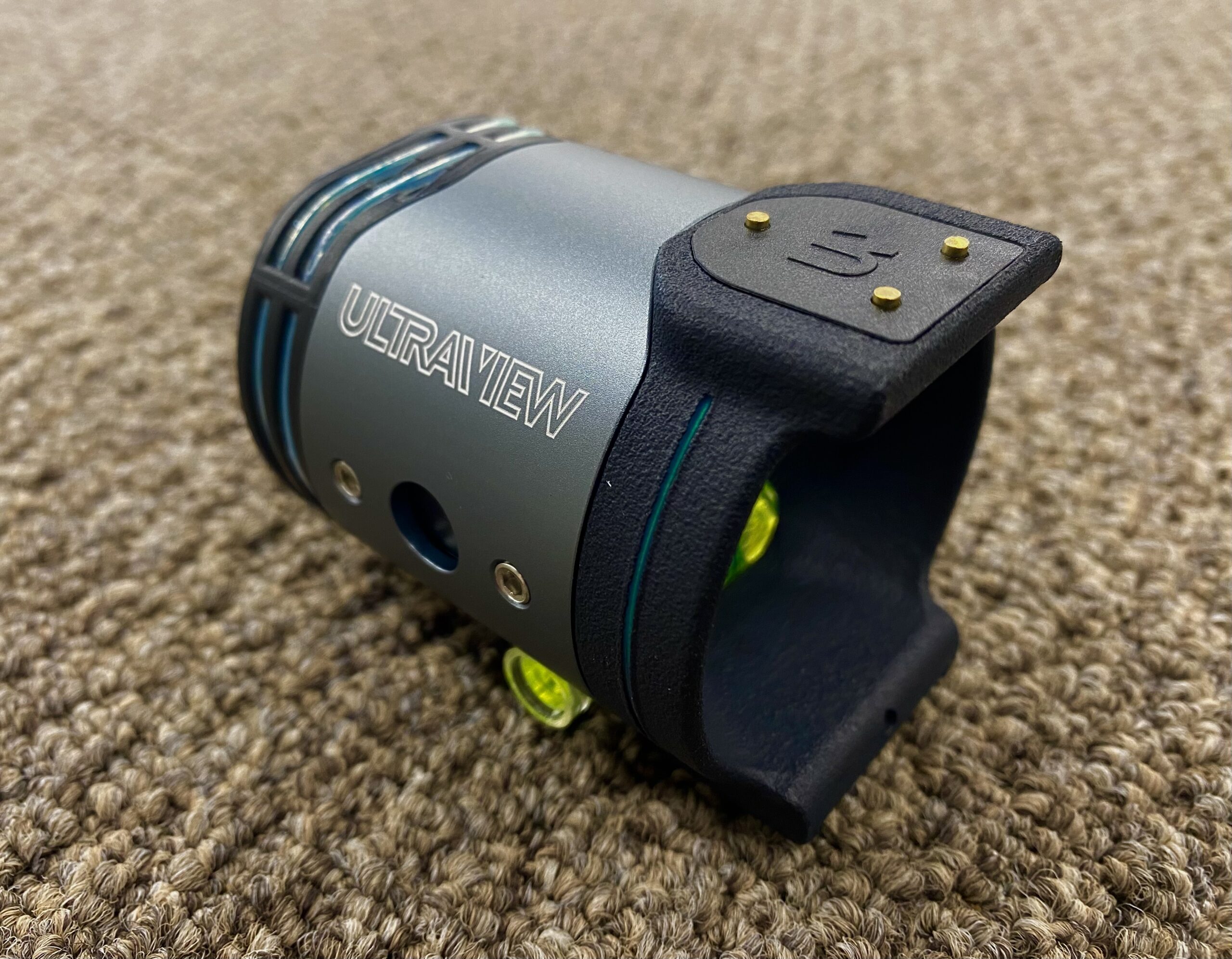
It’s based around a 41mm scope housing, which is optimally sized for bowhunting in that it provides for a good field of view and light transmission to the shooter’s eye.
The scope has an aluminum body, which can then receive various cartridge inserts. The cartridges allow the shooter to choose between single or double-pin aiming references, a lens with a drilled center for a stick fiber, or a lens with a dot that glows when illuminated. All the cartridges feature baffling that reduces glare. The point being you pick how you want to aim.
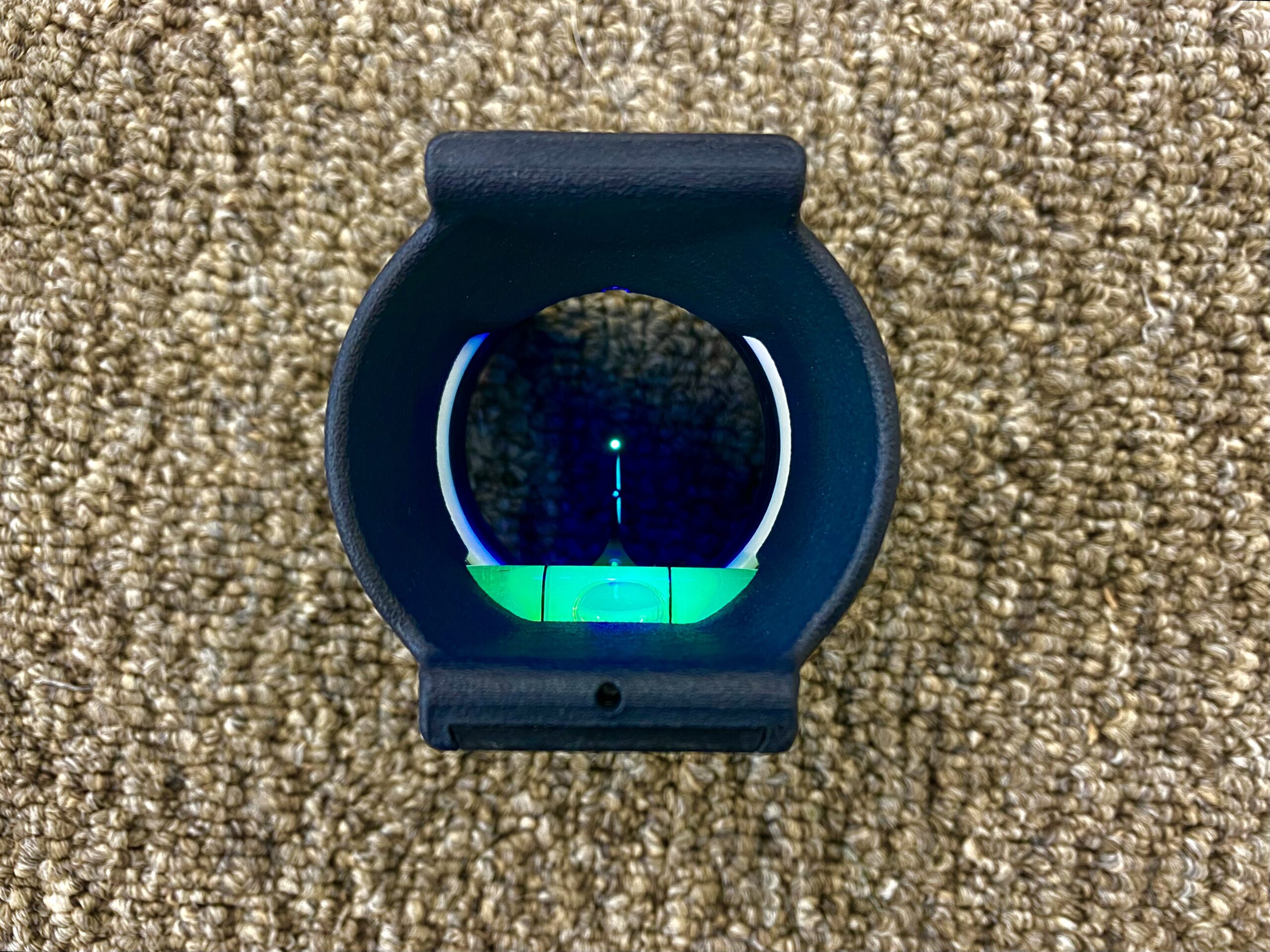
The front of the scope comes with a light cartridge with 5 LEDs for illuminating your aiming reference and sight level. Two CR 2025 batteries power the light.
Essentially, the UV3XL provides the best sight picture possible for your bowhunting rig. Where typical hunting sights provide a better overall sight experience, the UV3XL focuses exclusively on sight picture issues.
HHA Tetra Ryz
Key Features
- Big ergonomic wheel for adjusting the pin
- Includes a second, lower aiming reference useful for long-distance shooting and/or if an animal moves farther away after you come to full draw
- Dual indicators on sight wheel match each aiming reference
- Solid gear system with zero slop for precision dialing
- Rheostat scope cover allows for adjusting pin brightness
- Comes in direct mount or removable dovetail versions
Pros
- Can set the aiming pin fast and easy
- Second-axis adjustment screws are separate from the scope mounting screws
- Lots of fiber to light up the pin at prime time
- Aiming references are different colors
Cons
- Rheostat is not the simplest to adjust
- Paper sight tapes
The HHA Tetra Ryz is an adjustable single-pin sight that includes a second aiming dot at the base of the pin. That second aiming dot allows for extended range shooting. Two markers on the adjustable sight wheel are perfectly spaced to indicate the distance each aiming reference is set at as the sight is adjusted up and down.
The Ryz carries over all the features that made the 2021 version of the HHA Tetra so popular among bowhunters. It’s got a big wheel that turns easily and quickly to set the pin to the desired shooting distance. Turning the wheel drives the scope up and down on a vertical bar. Precision gears in the wheel mechanism mean there’s no wiggle as you zero in on the desired distance. When the sight-tape indicator hits the number you want, it sticks there.
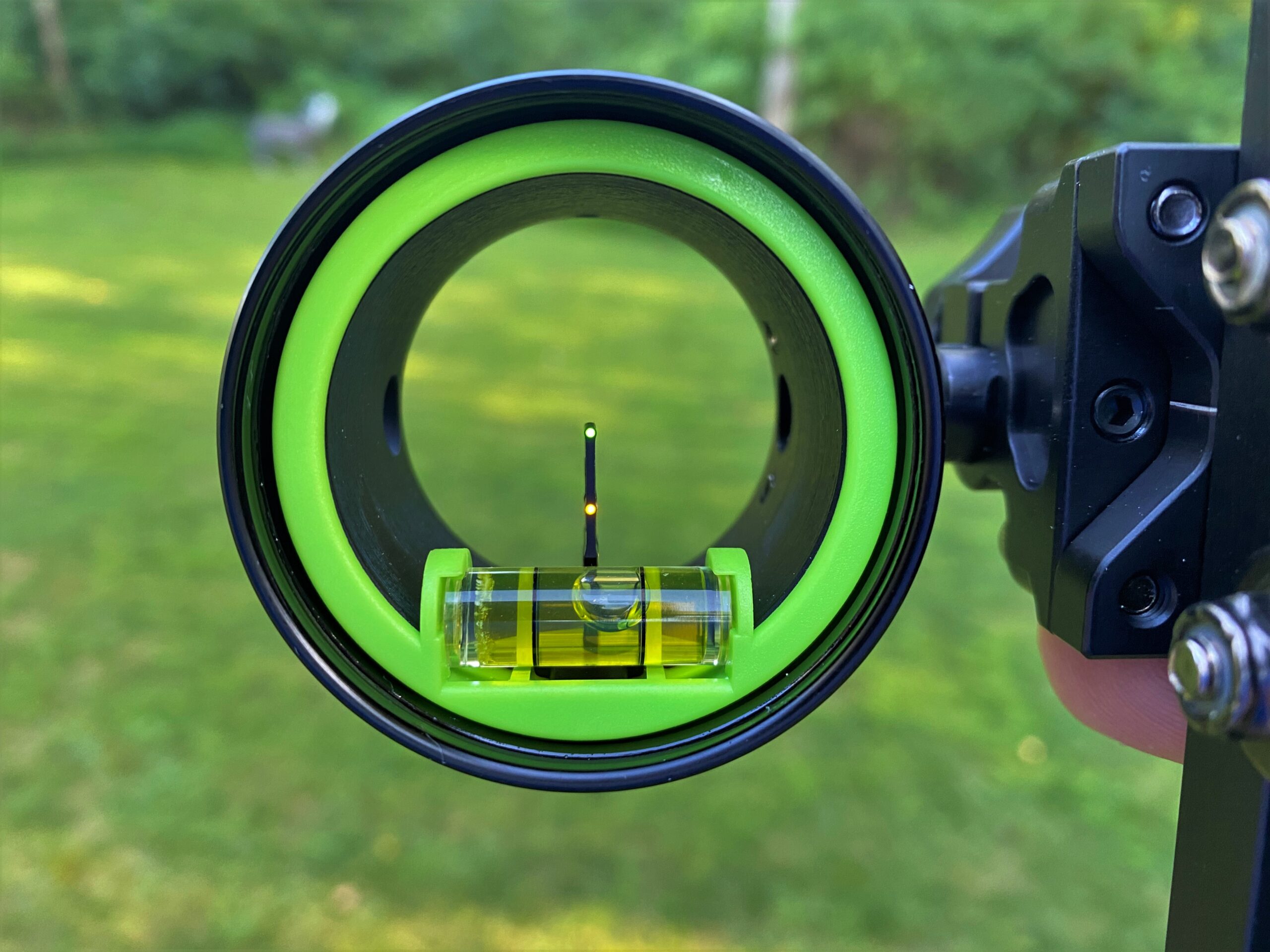
Quality fiber optic that wraps several times around the scope housing has ample surface area to capture maximum light so hunters can see the two aiming dots in low light when hunting often is best. A movable rheostat allows the hunter to control the light transmitted by the fiber in bright light.
Included with each sight are more than 50 sight tapes, which should mean there’s a tape for just about any hunter’s setup. The tapes are simply to apply to the wheel, and they’re easy to read.
Like all HHA Tetras, the Ryz allows for leveling the sight on both the second and third axes. Versions are available where the sight bar can be mounted directly to the riser, or you can mount a block to the riser, which receives a dovetail bar that can be set at different distances from the riser, and can be removed during transport in a case.
Things to Consider When Choosing a Bow Sight

Pin Size
Bow sight pins come in a variety of sizes, but the three most common you’ll encounter are .010, .019, and .029 inches. The smaller the pin, the more precise you can be in aiming. That can be important, especially if you plan to shoot long range. A .029 pin is nice for aiming at a deer 15 yards away, but back up to 70, and that pin is likely to cover half the animal’s body.
However, the smaller the pin, the less light it is able to transmit. So if you’re a tree stand hunter under a heavy canopy, a .010 pin will go dark as prime time arrives in the evening substantially before a .029 pin. As you get older, those smaller pins go dark even sooner.
Think about your age, your eyesight and what you need and want to see while aiming when you choose the size of the pins in your sight.
Fiber Length and Exposure
When you look through a sight and see glowing red, orange, green and/or yellow dots at the sight pin heads, the glowing is thanks to fiber optic. The fiber optic used in bowsights is a thin strand of plastic. Anywhere that fiber is exposed to light, it is gathering light. Any light it gathers is transmitted to the end of the pin, which is what bowhunters use to aim.
The longer the fiber is, and the more that fiber is exposed to light, the more light it can gather. The shorter it is, the less light it will gather. So in low light – prime hunting time – a pin with lots of exposed fiber will be more visible that a pin with a shorter fiber, or fiber that has more length covered.
If most of your hunting is spot and stalk on the open prairie, fiber length is not a huge deal. But if you’re going to be hunting in the timber, having a sight with lots of fiber is critical.
Leveling
As bowhunters, we chase game over uneven terrain, whether we’re aiming down from a tree stand or shooting across the side of a mountain. If your sight isn’t level to the Earth, then you can have problems with arrows hitting left or right of where you want them.
So getting a sight that allows you to level it on the second and third axes ensures that when you check your sight to get the bubble in the scope level into the middle while aiming, you know the sight truly is level. Leveling on the second axis involves pivoting the scope head up and down while the base is pinned to the sight bar. Leveling on the third axis involves pivoting the scope head like it’s a swinging door moving toward or away from the sight bar.
Not all sights include these leveling features. That’s ok, so long as you understand what you’re sacrificing. When you aim down from a tree stand, for example, you will have no way of knowing if the sight’s third axis is level, and so your arrow might impact left or right of where you’re aiming if it’s not level.
If you want to be confident the sight is true when you take aim, choose one that allows you the level the second and third axes.
FAQs
The answer really is up to you. With a fixed-pin sight, you always have an aiming reference for the entire range of your preset pins. If you’ve got five pins, you can have aiming references preset for 20, 30, 40, 50 and 60 yards. If your target animal moves after you come to full draw, just pick another pin for aiming. But if your target isn’t exactly at one of those distance, then you have to know how to gap shoot – aim by holding a pin high or low. With a single pin, you can set the pin to the exact distance of any target. But if an animal moves closer or farther after you set your pin, you have to reset it, which could cause you to miss a shot opportunity. It’s up to you to decide which setup you prefer.
Bow sights vary widely in cost from under $50 to over $1,000. The more expensive sights are going to have more and better features and capabilities. Take the Garmin Xero A1i. That’s got more technology built into it than many home appliances. You can find good quality sights really at any price point from $50-$1,500. Figure out what you want the sight to do and then shop accordingly. If you want to spend no more than $100, you can find a good sight in that range. Just understand it won’t be as bulletproof or feature laden as a $600 sight.
A sight is fastened to a bow essentially in one of two ways. Either the sight arm is mounted by screws directly to the bow, or a block is mounted to the bow, and the sight arm slides in and out of that block.
With a slide-in, slide-out sight, you can easily move the sight to adjust your sight picture through your peep. That is, you can adjust the sight so that when you look through the peep, the scope perfectly fills the peep. You get the scope ring to match the peep ring to know you are aligned.
Also, slide-in, slide-out sights can easily be removed for transport in a case. Turn a knob, and the sight slides out.
Direct-mount sights may or may not have multiple mounting positions to try to match the scope to your peep. If one doesn’t, then what you see through the peep is what you get. Your only option then is to change peep sizes.
However, you never have to worry about a direct-mount sight sliding because the holding knob came loose. The screws hold it in place. Period. They also tend to be quieter due to the direct connection.
Final Thoughts on the Best Bow Sights
Choosing the right sight for your bow is a critical piece to the accuracy puzzle. It is the last thing you’re looking through before an arrow is released, and often is the difference between filling a tag and going home with a sad story. But a sight can’t make up for poor shooting form or a bad bow tune. Work on those before diving into a high-end sight. When you get your shot and your tuning right, then one of the best bow sights can be just what’s needed to make you the most accurate bowhunter possible.
- Best Overall: Axcel Landslyde 5-pin
- Best Rangefinding Sight: Garmin Xero A1i Pro
- Best Single Pin: Black Gold Pro Dual Trac
- Best Budget: Redline RL4
- Best Lightweight: CBE CX-5
- HHA Tetra Ryz
